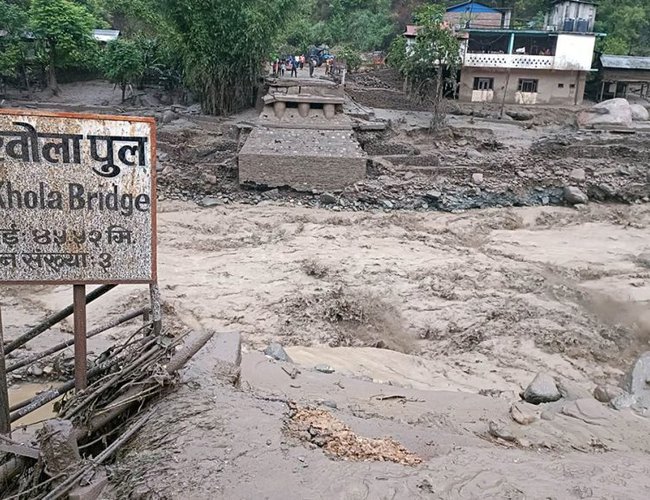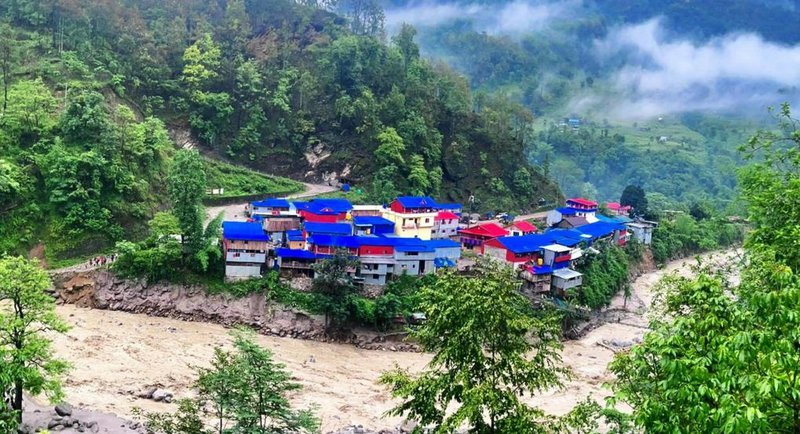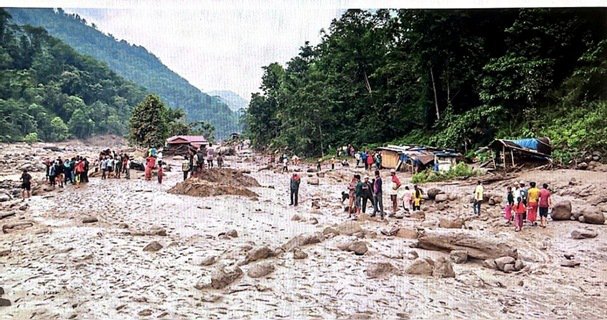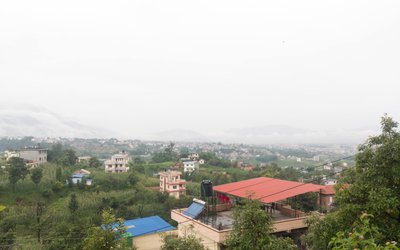
The recent flooding in the hilly districts of Koshi Province (Sankhuwasava, Taplejung, Patchthar and Ilam) due to continuous and high-intensity rain has caused significant losses of human lives including buildings, infrastructures and services in the region. The devastation is huge and widespread, as a result, the lifeline of the local citizens has almost come to a halt. Till date, ten people have lost their lives and around three dozen are missing. In addition, many people are injured, while some are rescued by using helicopters. The volume of damage and loss of infrastructures and services triggered by this flooding is mammoth. The cascading effect of this disaster is equally frightening, whereby threat of landslides and urban flooding due to over-flowing of storm water are becoming imminent. Many houses are already reported under the risk of landslides and this may soon demand immediate relocation of families to safer sites.
This phenomena of large-scale damage of hard earned infrastructures and services cannot be overlooked. 13 hydroelectricity projects of different sizes are damaged with a total capacity of 150 MW. Many settlements receiving electricity from the above projects are in dark today. Mobile network is scarcely working. Around 20 motor bridges (seven suspension bridges) including local roads are severely damaged, market centers (Dodan bazar- a major trading center of Taplejung) are at high risk while business of dairy products and green vegetables is seriously disrupted. In this process, few under-construction bridges are also damaged. Many vehicles carrying consumable items and construction materials are stuck in multiple places. The affected districts are disconnected from the main highway, while transport linkages between the local municipalities is also impacted. It is not difficult to understand that the infrastructures which are either washed-out or badly damaged rarely assessed the potential risks and their impact while planning and implementing the projects on the ground. The prevailing situation is causing serious challenges to security forces and local communities who are mobilized at large scale in conducting search and rescue, implementing relief operations and extending emergency medical support to disaster affected populations spread over multiple districts.

Though the exact estimation is yet to come, the initial figure of damage and loss is not less than a billion. It is not going to be easy to regain those infrastructures and services damaged or lost in this disaster in any short time. The frequency, severity and unpredictability nature of such disasters is only going to increase with the mounting impact of climate change worldwide. This situation is going to add more struggles and challenges to the districts, which are still way behind in meeting the development needs matching with the growing demands and aspirations of local populations. At one hand, we are adding new assets and building new infrastructures while on the other hand, they are swept-away by multiple disasters that we are encountering rather more regularly. This situation not only suspect the best use of the country’s scarce resources but it will also question the massive investment put into the infrastructure projects. Where and how far do we reach with this fraudulent model of development. It is a high time, and we must now focus on mainstreaming climate and disaster risk into the larger perspective of our development agenda. However, this is not going to happen automatically. The ‘whole of the government’ and the ‘whole of the society’ approach needs to be applied, in order to bring all the sectoral agencies including development partners, private sector, civil society and other relevant stakeholders onboard and on the same page. This process of integrating disaster and climate risk into development initiatives will ultimately lead to the building of resilient infrastructures which is inarguably the ‘need of the hour’.
Resilience means that the risks have been considered and managed to achieve an acceptable level of performance given the available information, and that capacities to withstand and recover from shocks are in place. The costs of protection need to be weighed against the consequences of damage or disruption. In the case of protective infrastructure (such as flood defenses) this will be the assets protected by the defenses. For other infrastructure, it will be the costs resulting from damage or disruption to the asset (e.g. business interruption from loss of electricity supply). Climate resilience focuses on the process used and outcomes achieved to assess whether climate change impacts have been considered and, if necessary, managed. Ensuring climate resilience is a continual process throughout the life of the asset. Efforts to achieve climate resilience can be mutually reinforcing with efforts to increase resilience to natural hazards.
Climate-resilient infrastructure is defined as “it is planned, designed, built and operated in a way that anticipates, prepares for, and adapts to changing climate conditions. It can also withstand, respond to, and recover rapidly from disruptions caused by these climate conditions”. Climate-resilient infrastructure refers to assets and systems including roads, bridges, communication and power lines that can resist extreme weather events.
To push building of climate resilient infrastructures, it is important that every infrastructure project should understand and assess the risks (it is exposed to- now and in future) and accordingly take actions to mitigate or minimize the risks before it is actually launched in the field. From climate risk perspective, every project has two situations- either the project may itself be found in risk/s or it may be creating new risk/s to the people and the local areas. As we do Initial Environmental Assessment (IEA) and Environmental Impact Assessment (EIA) to examine the impact of any project on the environment, we must now also do Initial Risk Assessment (IRA) and Risk Impact Assessment (RIA), to better understand and assess the impact of climate risks on the project. It is therefore highly recommended to urgently develop and put in place, the system of conducting IRA and RIA (following multi-sectoral and multi-stakeholders approach) both at the national and local level. It is a pity to report that in-spite 70 percent and more of the development budget is spent through the private sector, however the latter’s understanding of climate risk including its impact and solutions is very minimal. The knowledge building of the private sector is Indispensable to promote building of resilient infrastructures in the country. Unfortunately, this agenda of building climate resilient infrastructure by mainstreaming climate risk into development is yet to find an appropriate push from our national institutions like NDRRMA and other relevant ministries and departments in Nepal. On the other hand, the role of provincial and local governments including civil society cannot be underestimated in this regard. This is a significant and an apparent gap that propelled this scale of damage and losses in the region. At this stage, collaboration with an international institution like Coalition for Disaster Resilient Infrastructure (CDRI) based in Delhi, India would be highly supportive in developing necessary policies, tools and technologies for the development of climate resilient infrastructures in the country. The CDRI is a partnership of national governments, UN agencies, multilateral development banks, the private sector and knowledge institutions that aims to promote the resilience of new and existing infrastructure systems to climate and disaster risk in support of sustainable development.
The Principles for Resilient Infrastructure outlined by the UNDRR, offer a holistic approach to ensure that resilience is embedded into the planning and implementation of infrastructure projects. They contribute to creating a common understanding of how to improve infrastructure resilience in a risk context of increasingly complex cascading disaster impacts that can occur across the whole infrastructure system. Frequent disruptions to critical infrastructure undermine livelihoods, reduce productivity, and damage businesses. The Principles for Resilient Infrastructure offer an opportunity to overcome these challenges, ensuring resilience infrastructure is at the core of the decision making. More specifically, the principles for resilient infrastructure should:
- assist in raising awareness and setting a common basic understanding of what ‘resilient infrastructure constitutes
- form the basis for planning and implementation of infrastructure projects that take resilience as a core value
- raise engineering designs based on available and reliable data so parameters of safety and disaster risk mitigation are in place on new and retrofitting projects
- set out the desired outcomes of national infrastructure systems to establish resilience of critical services
- assist the public and private sectors in making risk informed policy and investment decisions
Governance is an essential component in achieving desired outcomes from resilient infrastructure. The OECD have proposed a policy toolkit on governance of critical infrastructure resilience. It requires governments to address seven interrelated governance challenges: creating a multi-sector governance structure; understanding complex interdependencies and vulnerabilities across infrastructure systems; establishing trust between government and operators; building partnerships; defining the policy mix to prioritize cost-effective resilience measures across infrastructure lifecycles; ensuring accountability and monitoring implementation; and addressing the transboundary dimension of infrastructure systems. To facilitate climate-resilient infrastructure, the government needs to focus their efforts on issues like improving and integrating risk assessment information into decision making, screening and factoring climate risks into public investments, enabling infrastructure resilience through policy and regulation and encouraging climate risk disclosure. Building climate resilience can involve a package of management measures (such as changing maintenance schedules and including adaptive management to account for uncertainty in the future) and structural measures (e.g. raising the height of bridges to account for sea-level rise).

Climate-resilient infrastructure reduces, but may not fully eliminate, the risk of climate-related disruptions. Climate risks to infrastructure can be reduced by locating assets in areas that are less exposed to climate hazards (e.g. avoiding new construction in floodplains), and by making the assets better able to cope with climate impacts when they materialize. The development of infrastructure should also consider the impacts on risk elsewhere: for example, the potential contribution to flood risk resulting from increases in paved surfaces.
Internationally, there are several good examples of building climate-resilient infrastructure, which is often considered as the starting point of the resilience building in the country. Climate-resilient infrastructure has the potential to improve service dependability, extend asset life, and guarantee asset returns. Infrastructure accounts for 88 percent of the projected costs of climate change adaptation. Key Infrastructure includes roads, bridges, motorways, and key supply lines, such as electricity, Internet, mobile, gas, and water supply. These are the vital organs that help run a country but also help during and after the disaster for better response and recovery. Infrastructure not only takes the direct losses from disasters but also contributes to the in-direct business and agriculture losses caused by disruption to the transportation and electricity supply. The infrastructures that are resilient to climate change can also support the achievement of the Paris Agreement, the Sustainable Development Goals and the implementation of the Sendai Framework for DRR.
Dr. Karna is an Urban Governance and DRR Specialist
The author can be reached through email- sumankarna@hotmail.com
- An Overview Of Early Warning System (EWS) In Nepal- How Inclusive And Resilient To Communities At Risk
- Oct 14, 2022
- Mainstreaming DRR And CCA Into Development Approaches- Indispensable To Secure SDGs Gains
- Jun 27, 2022
- Urban Resilience- A Growing Concern Of Urbanizing Nepal
- Aug 13, 2020
- Where We Are Falling Short?
- Jul 13, 2020

















